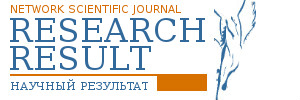Difficulties in communication of teenagers - the virtual aspect
Today, various studies of difficulties in communication of children and adults affect several aspects of their activity. Particular attention is paid to the topical forms of interaction through Internet communications. In this regard, the teenage audience, taking into account the increasingly expanding information space, increasingly chooses a virtual form of communication. This article describes the results of a study of difficult communication among adolescents. In this context, it is important to study the virtual aspect in the emergence and overcoming of communication difficulties. The aim of the study is to determine the content characteristics of parental and Internet communication in their relationship with individual characteristics of adolescents with difficulties in communication. Diagnostic means of the study include: an author's questionnaire with 14 questions for the study of mostly the virtual aspect of communication of adolescents; a questionnaire "The Analysis of family relationships" (ASV) by E.G. Eidemiller, V.V., Justickis; complex psychological diagnostics of communication (KPD) by Akopov G.V., Semenova T.V. The qualitative and quantitative analysis of the data was carried out according to the diagnostics results. The study has revealed the content characteristics of the factors of difficult communication: communication through Internet communications, parental influence in relation to the individual characteristics of the teenager. It was found out that the part of teenagers' activity on the Internet is higher than in real communication. If we analyze the answers of teenagers to the questions about the difficulties in communication (real and virtual), we will get the following average values: in real communication, "it is very difficult to communicate and make new friends" – 15.87%; in virtual – 9.83%. The analysis of parent-child relationships has shown the problems in family education in several directions: hyperguardianship, permissive (haphazard, chaotic), and even brutal treatment of children. Thus, it can be concluded that it is necessary to organize new forms of work with children and adolescents in the secondary school, the implementation of psychological support for adolescents and parents.

















While nobody left any comments to this publication.
You can be first.